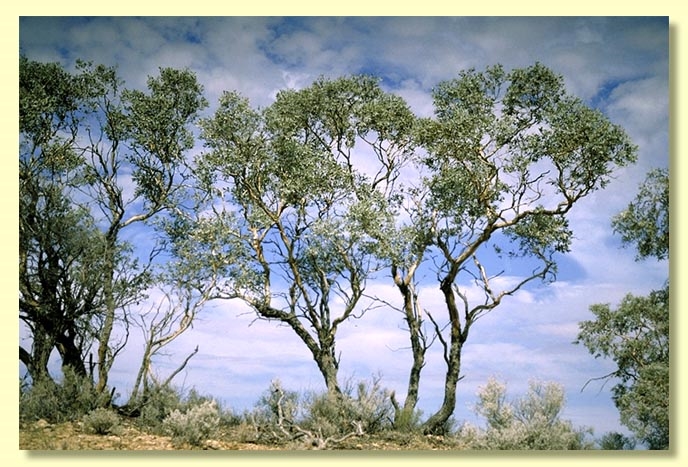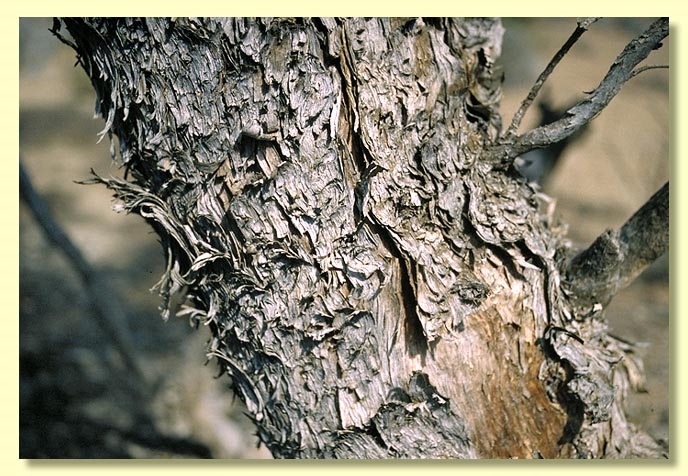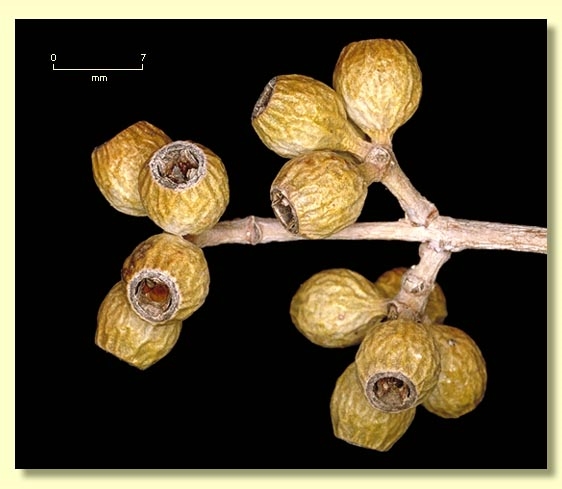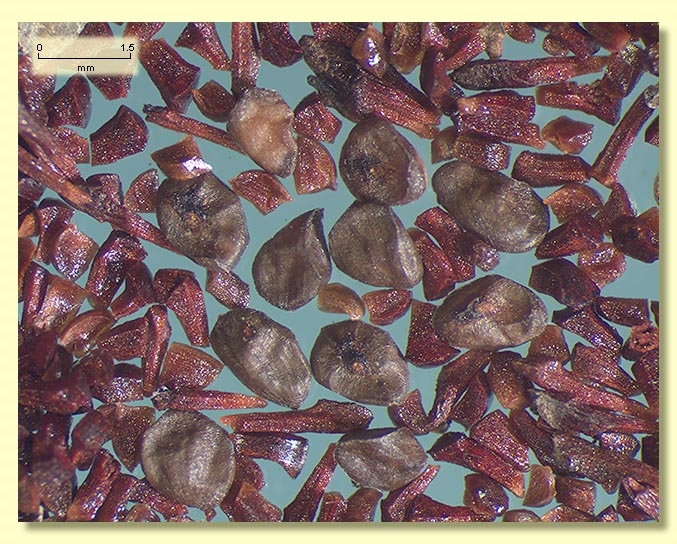Euclid - Online edition
Eucalyptus gillii
Eucalyptus | Symphyomyrtus | Bisectae | Destitutae | Subulatae | Decussatae
Bark smooth throughout or with some rough, flaky or box-type grey or brown bark on lower 2 m of larger stems, the flakes shed imperfectly giving a curly appearance; smooth bark white, cream, pink or grey. Branchlets usually glaucous.
Juvenile growth (coppice or field seedlings to 50 cm): stems square to rounded in cross-section, usually glaucous; juvenile leaves opposite for many pairs, sessile, narrow at first but becoming ovate to cordate to rarely lanceolate, 2–5.7 cm long, 2–5.3 cm wide, bases amplexicaul to rounded, rarely tapering or rarely connate (seen in cultivation), slightly discolorous, grey-blue to glaucous.
Crown often composed of juvenile leaves. Adult leaves, which are petiolate, lanceolate and alternate may only appear in upper crown of larger trees. Crown leaves opposite or alternate, petiole 0–0.7 cm long; blade lanceolate to broadly ovate to cordate, 3–8 cm long, 1.2–3.5 cm wide, base amplexicaul to rounded or tapering, rarely connate (seen in cultivation), slightly discolorous or concolorous, dull, green to grey-green or blue-grey to glaucous, side-veins usually greater than 45° to midrib, densely to very densely reticulate, intramarginal vein parallel to and remote from margin, oil glands mostly intersectional.
Inflorescence axillary unbranched, peduncles 0.4–1.5 cm long, buds 7, 9 or 11, pedicellate, pedicels 0.2–0.7 cm long. Mature buds more or less pyriform to oblong or ovoid (0.8–1.4 cm long, 0.3–0.5 cm wide), green to yellow under copious wax, scar present, operculum conical to horn-shaped or beaked (0.5–1 cm long), stamens irregularly flexed, anthers cuboid to globoid, weakly versatile to adnate, basifixed, dehiscing by lateral slits or pores, style long, stigma tapered to blunt, locules 3 or 4, the placentae each with 4 vertical ovule rows. Flowers pale yellow.
Fruit pedicellate, pedicels 0.1–0.8 cm long, barrel-shaped or truncate-globose, 0.4–0.9 cm long, 0.5–0.8 cm wide, glaucous, disc descending, valves 3 or 4, near rim level, surmounted by persistent, fragile style remnants.
Seeds grey, 1.2–3 mm long, ovoid or depressed-ovoid, dorsal surface smooth, hilum ventral.
Cultivated seedlings (measured at node 10): cotyledons Y-shaped (bisected); stems square in cross-section, glaucous; leaves opposite, sessile, cordate to ovate, 3–5 cm long, 2–3.5 cm wide, glaucous.
Flowering has been recorded in April, July, August, September, October and November.
A mallee or small tree of disjunct distribution, mainly in the Flinders Range in South Australia with a small occurrence in the Barrier Range north of Broken Hill in western New South Wales. The bark may be smooth or loosely rough. The crown is the defining feature of the species, being wholly of glaucous, cordate to ovate, juvenile leaves. The flowers are pale yellow.
Eucalyptus gillii belongs in Eucalyptus subgenus Symphyomyrtus section Bisectae subsection Destitutae because buds have two opercula, cotyledons are Y-shaped and branchlets lack oil glands in the pith. Within this subsection E. gillii is part of a large taxonomic series Subulatae further characterised by globoid basifixed anthers, grey smooth seeds with shallow longitudinal furrows, and fruit with persistent exserted style remnants. Series Subulatae is divided principally into four subseries based on the juvenile leaves, one with spiral, crowded seedling phyllotaxis (subseries Spirales), another with decussate and decurrent seedling leaves (subseries Decurrentes), another with decussate non-decurrent seedling leaves (subseries Decussatae), and a fourth with disjunct, petiolate seedling leaves (subseries Oleaginae).
Eucalyptus gillii is part of subseries Decussatae.
Because of its juvenile crown, E. gillii could only be confused with E. wyolensis, a rare endemic of the Great Victoria Desert in western South Australia. This species differs in the larger leaves, buds and fruits.
E. gillii is closely related to E. socialis and is considered by others as a neotenous variant of that species. E. socialis always has a crown of adult, alternate, lanceolate leaves. Where the two co-occur intergrades between them are common.
















